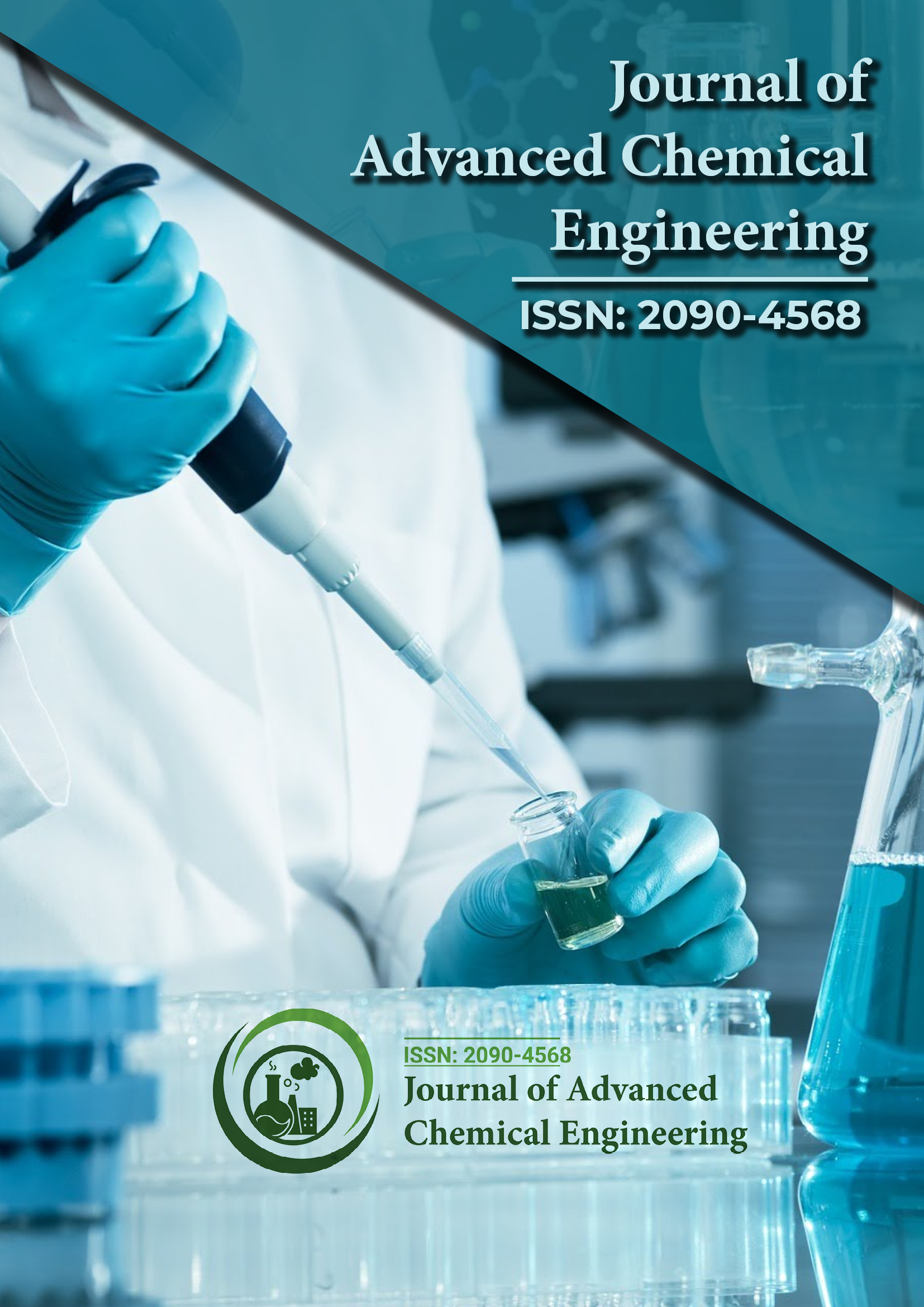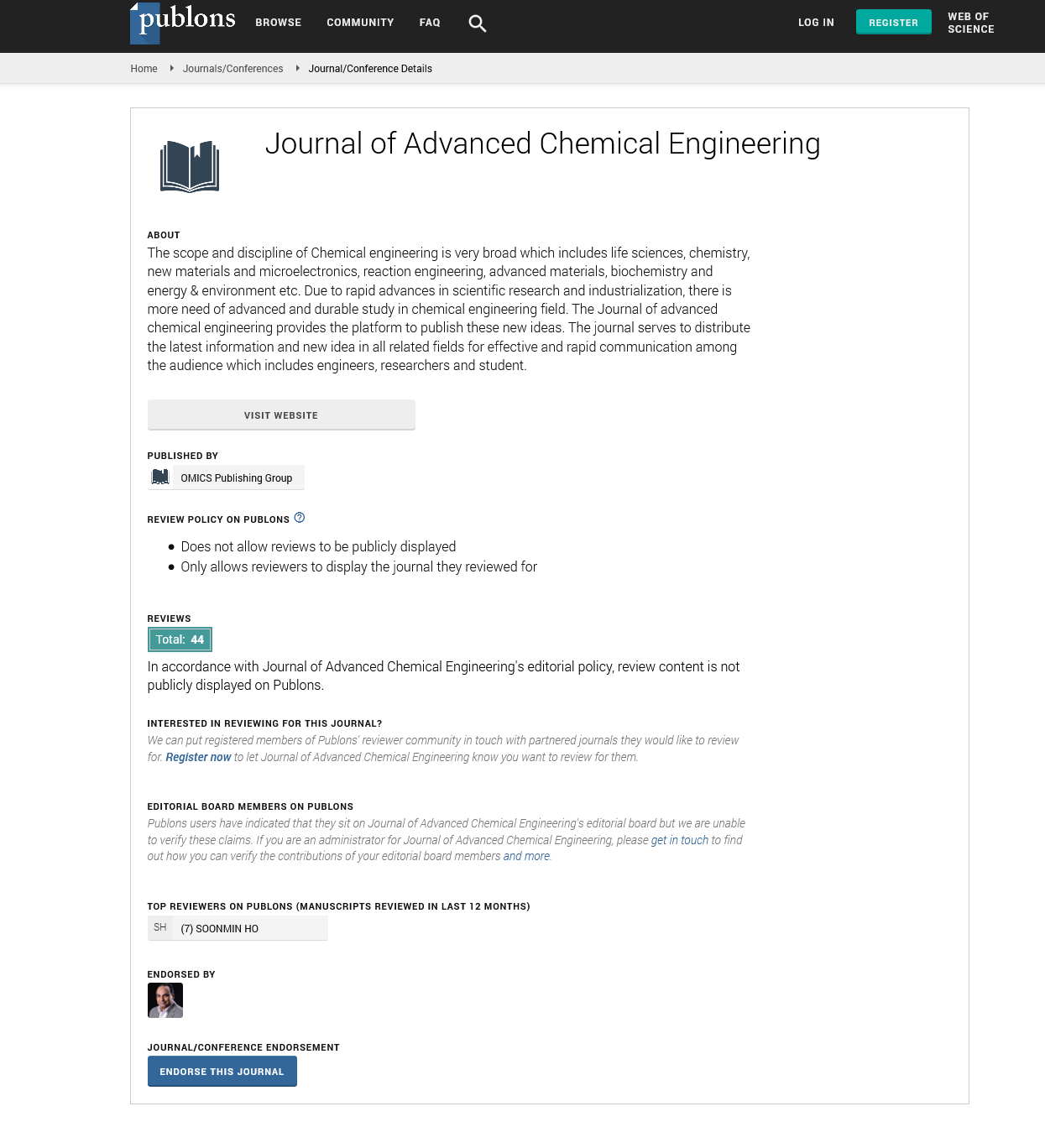Indexed In
- Open J Gate
- Genamics JournalSeek
- Smithers Rapra
- RefSeek
- Directory of Research Journal Indexing (DRJI)
- Hamdard University
- EBSCO A-Z
- OCLC- WorldCat
- Scholarsteer
- Publons
- Geneva Foundation for Medical Education and Research
- Google Scholar
Useful Links
Share This Page
Journal Flyer

Open Access Journals
- Agri and Aquaculture
- Biochemistry
- Bioinformatics & Systems Biology
- Business & Management
- Chemistry
- Clinical Sciences
- Engineering
- Food & Nutrition
- General Science
- Genetics & Molecular Biology
- Immunology & Microbiology
- Medical Sciences
- Neuroscience & Psychology
- Nursing & Health Care
- Pharmaceutical Sciences
Perspective - (2025) Volume 15, Issue 2
Bioprocess Intensification in Advanced Chemical Engineering: A Pathway to Industrial Efficiency
Helena Varga*Received: 30-May-2025, Manuscript No. ACE-25-29807; Editor assigned: 02-Jun-2025, Pre QC No. ACE-25-29807 (PQ); Reviewed: 16-Jun-2025, QC No. ACE-25-29807; Revised: 23-Jun-2025, Manuscript No. ACE-25-29807 (R); Published: 30-Jun-2025, DOI: 10.35248/2090-4568.25.15.368
Description
In recent years, the field of chemical engineering has been increasingly shaped by the concept of intensification, particularly in the context of bioprocessing. Bioprocess intensification aims to deliver higher productivity, lower resource consumption, and reduced environmental impact while ensuring economic viability at industrial scale. This idea is closely linked to global demands for sustainable production of food, energy, chemicals, and pharmaceuticals. As industrial operations continue to expand, chemical engineers are constantly developing innovative strategies that not only meet current efficiency challenges but also set the foundation for future manufacturing models.
The push toward intensification began with the recognition that traditional large-scale reactors and unit operations were becoming inadequate for modern challenges. Conventional systems often require substantial capital investment, consume vast amounts of water and energy, and produce significant waste streams. This inefficiency is no longer acceptable in a world increasingly concerned with environmental degradation, climate change, and depletion of natural resources. Instead, the chemical engineering community is moving toward compact, modular, and integrated systems that emphasize circularity and resource optimization.
A core aspect of bioprocess intensification is the adoption of continuous processing over traditional batch systems. Batch reactors, while reliable, are inherently limited by downtime between runs, scale-up challenges, and inconsistent product quality. Continuous bioprocessing, on the other hand, offers uninterrupted operation, real-time monitoring, and consistent output. For instance, in the pharmaceutical industry, continuous fermentation platforms allow microbes or mammalian cells to produce therapeutic proteins at higher yields while reducing overall costs. This transformation requires sophisticated monitoring tools, such as Process Analytical Technology (PAT), that ensure every stage of production is tightly controlled and optimized.
Another pillar of intensification is microreactor technology. These small-scale devices utilize microchannels to carry out chemical and biological reactions under highly controlled conditions. Their enhanced surface-to-volume ratio allows for superior mass and heat transfer, drastically improving reaction efficiency. In bioprocessing, microreactors have been deployed to optimize enzymatic reactions, streamline metabolic engineering experiments, and test new microbial strains under tightly controlled conditions. By scaling out instead of scaling up, microreactors enable flexible, distributed production systems that can be located closer to demand centers, reducing transportation costs and emissions.
Membrane technology also plays a vital role in bioprocess intensification. Advances in nanostructured and functionalized membranes have enabled more efficient separation of valuable products from complex mixtures. For example, membrane bioreactors integrate biological treatment and filtration in a single unit, significantly reducing footprint and improving water recovery rates. Similarly, affinity membranes selectively capture target proteins or metabolites, minimizing purification steps. These innovations directly contribute to lowering production costs and enabling a more sustainable process chain.
Process intensification is not only about improving hardware but also about leveraging computational advances. Digital twins, artificial intelligence, and machine learning are transforming the way chemical engineers design and operate bioprocesses. By creating virtual replicas of physical systems, digital twins allow engineers to simulate different operating scenarios, predict system responses, and implement real-time optimizations without interrupting actual operations. Machine learning algorithms analyze large volumes of process data to identify hidden correlations, forecast product yields, and detect anomalies before they escalate into costly failures.
Bioprocess intensification also intersects with synthetic biology. The ability to engineer microbial and mammalian cells with precision opens opportunities for designing strains that are inherently more efficient, resilient, and capable of producing complex molecules. Coupled with intensified reactors and continuous monitoring, these engineered organisms can drive the next generation of bio-based products, ranging from biofuels to bioplastics and therapeutic biologics. The integration of biological and engineering innovations illustrates the multidisciplinary nature of modern chemical engineering, where biology, physics, materials science, and computer modeling converge to address pressing challenges.
Industrial adoption of intensification strategies, however, is not without challenges. Transitioning from established batch systems to continuous, modular units requires significant investment, workforce retraining, and regulatory adjustments. Regulatory agencies must adapt to new paradigms where quality assurance is built into the process rather than tested at the end. Companies must also develop robust supply chains that can accommodate decentralized production systems. These hurdles underline the need for collaboration among academia, industry, policymakers, and financial stakeholders to ensure smooth implementation of intensified bioprocessing strategies.
Citation: Varga H (2025). Bioprocess Intensification in Advanced Chemical Engineering: A Pathway to Industrial Efficiency. Adv Chem Eng. 15:368.
Copyright: © 2025 Varga H. This is an open-access article distributed under the terms of the Creative Commons Attribution License, which permits unrestricted use, distribution, and reproduction in any medium, provided the original author and source are credited.

